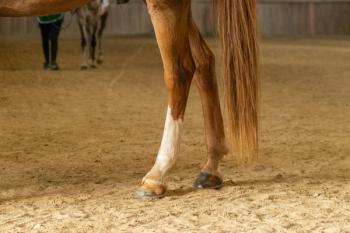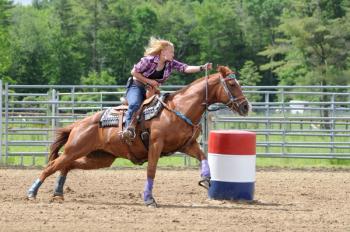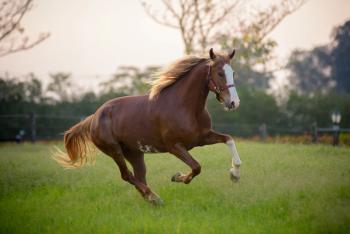
Evaluation of poor performance in the equine athlete (Proceedings)
Common sources of poor performance: lameness, upper airway, lower airway, cardiac, myopathy, or any combination of the above.
Common sources of poor performance
• Lameness
• Upper airway
• Lower airway
• Cardiac
• Myopathy
• Or any combination of the above
Incidences of causes of poor performance
• Morris EA et al (EVJ 1991;23:169-174)
o 275 racehorses
o 84% had more than one problem
o 40% dx with airway obstruction
• Martin BB et al (JAVMA 2000:216(4):554-558)
o Definitive diagnosis only in 73.5%
o 43% dynamic airway obstruction
o 22% clinically important arrhythmias
o 15% had concurrent airway obstruction
o 7% rhabdomyolyis
o 10% lameness
o 36% subclinical myopathy
• Wilsher S et al (EVJ 2006:38(2) 113-118)
o Musculoskeletal problems
• 55% of 2 year olds
• 45% of 3 year olds
• Sore shins the most common problem (29%, 12%)
o Respiratory problems
• 16% of 2 year olds
• 13% of 3 year olds
• IAD the most common problem (13%, 8%)
• Inflammatory airway disease
o 22-50% incidence
o Neutrophilic inflammation in bronchi, bronchioles, and trachea
o Tracheal mucus accumulation
o BAL
• total nucleated cells
• Total and % neutrophils
• Total and % lymphocytes
• Mast cells
• Eosinophils
o TTW = neutrophilic inflammation
o Associated with EIPH, environmental exposure to respiratory irritants, specific bacteria
Diagnostics for poor performance
• Field diagnostics
• High speed treadmill exam
Upper airway
• Resting endoscopy
• Nasal occlusion
o Achieves pharyngeal and tracheal pressures consistent with maximal exercise (Holcombe SJ et al AJVR 1996 Sep;57(9):1258-60)
• Treadmill endoscopy
• Field exercising endoscopy
• Evaluation of poor performance
Lower airway
• Disorders include:
o Inflammatory Airway Disease (IAD)
o Exercise Induced Pulmonary Hemorrhage (EIPH)
• Diagnostics
o Bronchoalveolar lavage
• 100-250 ml of sterile fluids drawn up into 60cc syringes
• 50 ml mepivacaine
• Pass blind or endoscopically guided
• Infuse mepivacaine as passing tube
• Pass until wedged
• Inflate cuff
• Infuse fluids
• Draw back until no further recovered (expect 40-60% retrieval)
o Transtracheal wash
• Endoscopic guided:
• Teflon tubing passed through biopsy channel in endoscope (use guarded catheter if culture desired)
• Infuse 100 ml sterile fluids
• Aspirate for retrieval of fluids and sample
• Percutaneously
• Mid-cervical region between tracheal rings
• Aseptic preparation
o Malikides et al recommends using both to evaluate the entirety of the lower airway (Aust Vet J 2003 81:685-7)
o Pre and post exercise?
• TTW values shown to be different pre and post-exercise (Malikides et al Aust Vet J 2007 85(10):414-419)
o Endoscopic tracheal mucus scores
o IAD associated with presence of specific bacteria so culture may be important. (Wood JLN et al J Clin Microbiol 2005;43:120-126)
o Cytology
• Total nucleated cell counts (normal = < 300 cells/µL)
• % macrophages ( normal = 30-60%)
• % lymphocytes (normal = 30-70%)
• % neutrophils and appearance (normal = < 5% non-degenerate)
• Mast cells (normal = occasional)
• Eosinophils (normal = occasional)
• Mucus
• Hemosiderophages
o Arterial blood gases during exercise
• Cannot be taken alone as a reflection of total airway function
• PaO2, SaO2
• Evaluation of oxygen exchange that can be compromised by both upper and lower airway disease
o Other bloodwork
• Lactate
• Marked increases indicate poor conditioning
Cardiac
• Echocardiography
o Performed within 3 minutes of maximal exercise while HR still > 100 bpm
• Right and left ventricular diameter (end diastole and systole)
• Interventricular septal wall thickness
• Left ventricular free wall thickness
• Fractional shortening
• Aortic root diameter
• Diameter of left atrial appendage
• Ejection time
• Septal to E-point separation
o Electrocardiography
• Obtained at rest and throughout test with Holter monitor or telemetry
• Evaluated for clinical significant arrhythmias
• Atrial or ventricular premature depolarization
• Ventricular tachycardia
Myopathy
• Obtain pre and post-exercise (30 min to 4 hours) CK
• May observe clinical rhabdomyolysis following exercise
• Sub-clinical myopathy = CK > 1,000 U/L
Newsletter
From exam room tips to practice management insights, get trusted veterinary news delivered straight to your inbox—subscribe to dvm360.






